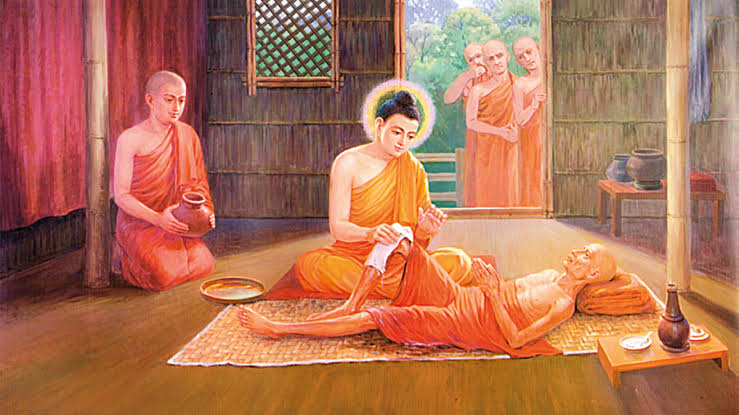Looking at the human body from a Buddhist Perspective

By
Dr Justice Chandfadasa Nanayakkara
Change is just a fact of life, we have to accept it and live with it. Impermanence is the cornerstone of Buddhist teachings and practice. All that exists is impermanent and nothing lasts.
Buddhists should fully appreciate this simple but profound truth. Annica (impermanence), dukkha (suffering) and anatta (Selflessness) are the three characteristics common to all phenomenal existence.
Impermanence is inescapable and essentially a painful fact of life. Life is perpetually in a state of flux and change. The great Greek philosopher Heraclitus observing the fluid nature of things declared “No man ever steps in the same river twice, for it is not the same river and he is not the same man” We must recognize this fact of impermanence and learn to see the subtle reality that the human body too undergoes an incalculable series of mutations and change every moment. The human body never remains the same for two consecutive moments, as it is subject to law of impermanence.
In Buddhism, mindful reflection on the human body is considered a fundamental tool for our overall wellbeing that helps us gain an insight into the fact of impermanence, as we move through our life.
It is said that Buddhism recognizes forty subjects of meditation which can differ according to the temperaments of persons. Contemplation of the human body is one of them.
Of all the subjects of meditation, reflection on the human body as a subject is not popular among certain people particularly in the Western world. They regard it as a subject that may be somewhat unpleasant not conducive to human wellbeing. In Buddhism it is called asuba bavana or mindfulness of the impurities of the body. It is all about our physiology and individual body parts and organs internal as well as external.
This subject of meditation is unique to The Buddha’s teachings. Normally, people who are infatuated and intoxicated with sensual pleasures develop an aversion towards this subject of meditation.
There is also a misconception among some people that such contemplation would lead to melancholic morbid and pessimistic outlook on life.
In Buddhism, mindful reflection on the human body is considered a fundamental tool for our overall wellbeing that helps us gain an insight into fact of impermanence, as we move through our life
But reflection on the human body as a subject of meditation is an essential component of The Buddha’s teaching, as knowledge of the true nature of the human body would be essential to our wellbeing.
In order to comprehend the true nature of the human body, we got to put aside our preconceived ideas about it and ask ourselves dispassionately, Is the body something attractive or not?
What is it composed of? Is it something that is everlasting? Most people are under delusion that the body is very attractive and that it is something desirable.
Repulsiveness of the body can be clearly seen if we do not wash our body for a few days. We got to keep washing it otherwise the body would stink before long and become unbearable. We feel certain parts of our body so abominable.
For instance, if a few strands of hair found in our plate of rice, we tend to lose our appetite. There are many such aspects of the body that we can look at to determine whether it is a pleasant thing or not, whether beautiful or not. (Rev. Ajaan Pannavaddho)
As world lings, our mind has been enamoured with the body. We generally look at the human body as a thing of beauty. We regard it as beautiful and spend a lot of time, energy and money to make it more beautiful and attractive.
We admire beautiful eyes, teeth, face, hair and figure. We spend a lot of time to feed the body, to clothe it, to cleanse it, to wash it, to beautify it and rest it. People like to look as young as they can, as long as they can and increase their chances of having lifelong healthy body.
As Buddhists we have look at the human body from a realistic point of view. From the Buddhist perspective, the human body is a bag of impurities. Moreover, we cannot control everything that happens in our lives. For instance, we cannot change the natural ageing process of our lives.
Ageing is a gradual, irreversible and inevitable process. Everyone should come to terms with his or her ageing process With time, we all get visible lines and wrinkles on our face. It is natural with the passage of time for our face to lose its youthfulness.
We notice our skin becoming thin and drier. We lose our teeth. We tend to lose our mental faculties. A lot of people particularly women feel inadequate about their physical appearance. They always think of ways of becoming younger and attractive.
People spend an enormous amount of money on cosmetic procedures, skin care and grooming products to make themselves presentable. But it must be understood that use of grooming products available in the whole world will not enable a person to recover his or her youthfulness, as the time takes its toll.
When fears centre around ageing, decay and disease, we cannot overcome them by pretending they do not exist. Only facing these inevitable features of life can bring insight and relief to us.
Therefore, contemplation of the human body (kayanupassana) enables a person to gain an insight into the real nature of the human body. The Buddha dealt with thirty-two parts of the human body and spelt out its constituents.
Asuba bavana in brief is the contemplation of those thirty-two impure parts of the human body in their true nature. Practice of mindfulness of the human body can begin by contemplating on this very passage from satpattana sutta.
“In this very body, from the soles of the feet up, from the crown of the head down, surrounded by skin, full of these various mean impurities, he reviews thus”. (Satipatthans Sutta, trans, Ven, Nanamoli).
In order to comprehend the true nature of the human body, we got to put aside our preconceived ideas about it and ask ourselves dispassionately, Is the body something attractive or not? What is it composed of? Is it something that is everlasting?
Head hair (Kesa), Body hair (Loma), Nails (Nakha), Teeth (Danta), Skin (Taco), Flesh (Mamsam), Sinews (Naharu), Bones (Atthi), Bone-marrow (Atthiminjam), Kidneys (Vakkam), Heart (Hadayam), Liver (Yakanam), Membranes (Kilomakam), Spleen (Pihakam), Lungs (Papphasam), Gut (Antam), Gut (Antagunam), Gorge (Udariyam), Dung (Karisam), Bile (Pittam), Phlegm (Semham), Pus (Pubbo), Blood (Lohitam), Sweat (Sedo), Fat (Medo), Tears (Assu), Grease( Vasa), Spit (Khelo), Snot ( Sinhanika), Joints (Lasika), Urine (Muttam), lastly Brain Skull making up thirty two parts. Observation of repulsive nature of our body constantly and rapidly leads a person to gain a realistic perspective of the human body.
In the world today, for many people most enduring desire is sexual desire, so to deal with this phenomenon contemplation on the impure side of the human body would be important.
At a time, people are subjected to bombardment of sensuality by way of the mass media resulting in defilement of the mind notably lust, greed and attachment reflection on this aspect of human body enables a person to gain tranquility.
When the emphasis is so much on sensuality such as youthfulness, beauty, we find the darker sides of life get pushed away and swept under the carpet.
Contemplation on dead body, is another appropriate subject recognized in Buddhism, in which the Buddha identified nine stages of decomposition of the dead body. The Buddha showed us how to realize this truth through contemplation on the human body. He drew attention to the activities of the body, how it is formed and inevitably passes away. Intelligent contemplation on the dead body will strengthen ones mind sufficiently to develop Samadhi, which can be achieved by anyone.
All beings that born must die eventually. All creatures that inhabit the earth, whatever their status undergo the common fate of death. Consequent to the death of a person, the body undergoes a series of biological changes and the decomposed body is returned to the earth as an organic matter. It is part of this earth. When we look at a dead body properly, we realize that body does not belong to us nor is it really ourselves or a part of ourselves.
One who has not realized this truth will be forever seeking other existence in different form prolonging the journey through samsara. Only a developed mind can see an end to this samsaric journey.
When you attend a funeral, looking at a dead body, one can reflect for a few moments in this manner. What has happened to you will also happen to me one day sooner or later.
The body which I thought was mine will one day become food for the worms and other creatures. The attractive form will inevitably disintegrate into pieces of bones and become a mass of rotting flesh.
In a few days, the whole body will assume a disgusting and repulsive shape and form exuding foul-smelling odour. My attractive body which I nurtured throughout will also undergo the same fate.
In this manner, by comparing body with a dead body, one can develop tranquility (Rev. K. Wipulansiri).
It also helps immensely in recognizing and understanding the Tri-lakana as well as in controlling lust and attachment towards the human body.



